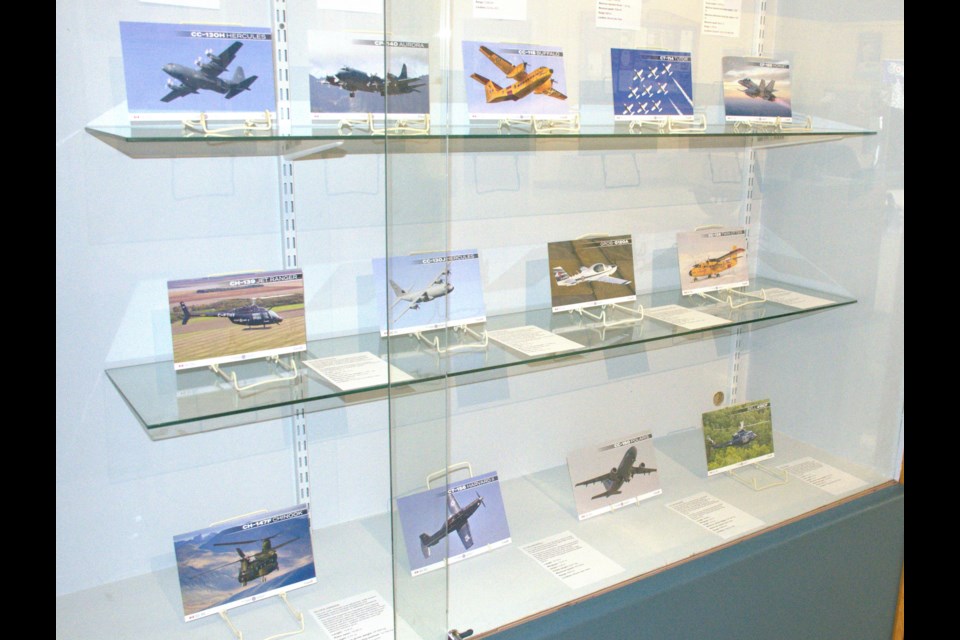MOOSE JAW — Moose Jaw was home to a major air training base during the Second World War where planes like the Harvard and Anson trained, aircraft that the Western Development Museum (WDM) now proudly showcases.
The WDM helped celebrate the Royal Canadian Air Force’s 100th birthday by offering guided tours of the air-focused displays recently. Veterans Alan McLellan and Farouk Nejah gave the tours and displayed their knowledge and passion for this branch of the military.
McLellan served as a transport driver from 1974 to 1999, while Nejah is a flying instructor at 15 Wing Air Base.
The first stop was a display case featuring pictures of 13 aircraft. Nejah gave a brief explanation of each machine, noting that the military planned to replace — or had already retired — every plane and helicopter shown with something more technologically advanced.
“And we’re going to see the Harvard IIs, the plane we currently fly here in Moose Jaw, … changing the aircraft soon. There is a FACT (Future aircrew training) program, so there will be a new airframe (and) two new aircraft … very soon,” said Nejah.
The next visit was to a room showcasing the 431 (Snowbirds) Air Demonstration Squadron. McLellan pointed to the iconic logo and explained that it resembles a wheat stalk because the aerobatic team is based in a Prairie province where wheat is a main crop.
As a tribute to their home province, the Snowbirds had a crest created featuring four speedbirds in formation and resembling an ear of wheat. The speedbird is also shown on the bottom of each aircraft.
Another interesting fact is how the Snowbirds acquired their name, McLellan continued. That happened after the air base’s elementary school held a naming contest in June 1971, with Grade 6 student Doug Farmer submitting the winning moniker.
The tour moved to a wall dedicated to 10 Snowbirds’ pilots killed while flying since 1972. McLellan pointed to Capt. Michael VandenBos, who died at age 29 in 1998, and said he was working at 15 Wing when the pilot was killed.
“It was a very sad day. The ‘missing man’ formation was quite touching … ,” the veteran said. “I was a driver there and drove some of the family and that (during the ceremony in Moose Jaw).”
Three impressive airplanes were also present in the Snowbirds’ gallery, including a CT-133 Silver Star jet, a CT-114 Tutor and a Beechcraft Musketeer trainer painted to look like a tiger.
The next stop was the hall featuring aircraft from the Second World War era.
On display was a piston-powered Rolls Royce Merlin MK. III engine, used in airplanes such as the Mosquito fighter, the Lancaster bomber and the famous Spitfire fighter. It was a 12-cylinder, liquid-cooled engine with 1,030 horsepower.
“… what a noise it would make. But an aircraft noise you would enjoy,” said McLellan.
Nejah said that this turbo-prop engine produced significant power for its time, but it was large and tough to maintain. Conversely, modern military jet engines are turbine-powered and much smaller but still powerful — the Snowbirds’ Harvard jets can produce 1,100 HP.
Meanwhile, a mural featured a scene from Moose Jaw’s first municipal airport from the 1920s. This venue was located on Caribou Street West — where Mercury Marine Service is — while one hangar still exists.
McLellan then talked about his favourite plane, a Vickers Vedette, a “boat with wings” that the RCAF used for aerial mapping and forest fire patrols.
“This plane here is believed to be one of two restored Vedettes in the world,” he stated.
The hall then transitioned into how a British Commonwealth Air Training Plan air base in Saskatchewan looked during World War II, with one of the actual hangars — still in good condition —present.
McLellan and Nejah spoke glowingly about the many well-known planes that contributed to the war effort, including the Harvard MK. IV, Fairchild Cornell, Cessna Crane, Avro Anson MK. I and the Tiger Moth.
“A part of history was made in Saskatchewan in (the Anson). It contributed to the liberation of Europe,” said Nejah.
The tour concluded with planes that Saskatchewan used in the 1940s and ’50s for air ambulance services.




